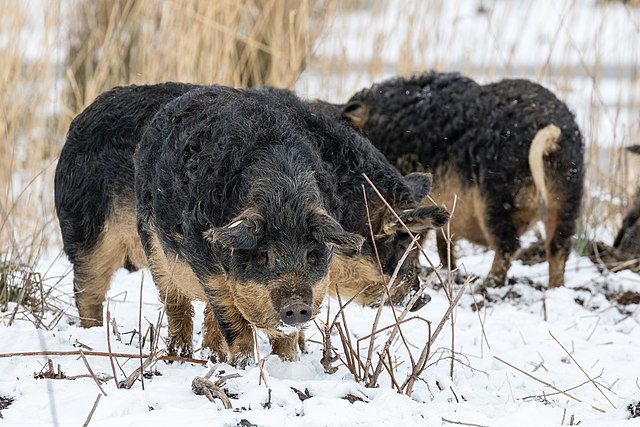Mangalitsa Pork
Mangalitsa Pigs are a heritage breed of pig that originated in Hungary. They are known for their coat of thick curly hair and for the high fat content of their meat. Mangalitsa pigs were almost extinct in 1980, but breeding efforts in Europe and the export of breeding stock to the United States in 2007 rescued breed. And you will be glad that these pigs are still around when you taste Tim’s Asian-inspired preparation of Mangalitsa pork belly! He has used this dish as a course for our private 7 course dinners and for group wine dinners. It is always popular.
Modern pigs that are raised in factory farms have been bred to mature quickly and to have meat with a low fat content. Lowering the fat content was considered healthy and desirable by consumers. The problem is that flavor comes from fat, and the pork that is sold is most grocery stores is not very flavorful. Chef Tim wanted to find a source for more marbled pork that was raised locally. Luckily our friend Gottfried Hart, owner of 6 Linden Specialty Grocery in Three Oaks, Michigan, knew just the people, and the pig, who could deliver the flavor that Tim was looking for.

Mike and Michelle De Schaaf, owners of 1936 Meadowbrook Farm, raise Mangalitsa pigs in Benton Harbor Township – which is about 40 miles south of South Haven. They have many projects, including growing grapes and making wine, but they are dedicated to the Manglatisa breed. “The fat from our pigs is as pure as you get,” said Mike in an interview with the local newspaper. “It creates a rich mouth feel, and when you have eaten the speck or lardo with a glass of wine, you find that your hunger is satisfied. It’s not a greasy fat. Sixty percent of the fat from our pigs is mono-unsaturated, far more than olive oil.” The pigs are pasture-raised and fed a mixture of potatoes and other feed, but no corn or soybean.
To prepare the pork belly, Tim first marinates a large cut of the meat in an Asian marinade for 24 hours. Then the meat is cooked at 135 degrees for 24 hours and 155 degrees for another 5 hours in a sous vide (a temperature controlled water bath). Right before serving the pork belly is cut into smaller pieces, pan-seared, and placed in the oven to warm it to the desired serving temperature. Tim prepared 5-spice pear puree, blueberry gastrique, and apple and blueberry salad to complement the rich meat with warm spiced fruits.
We look forward to featuring this dish and other cuts of Mangalitsa Pork on future dinners! See our gallery page for example menus and items we feature for breakfast and dinner.
